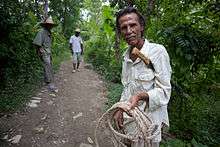Marabou (ethnicity)
 Marobou Haitian man | |
| Total population | |
|---|---|
| (Unknown) | |
| Regions with significant populations | |
| Haiti, United States, Canada, France[1] | |
| Languages | |
| French, Haitian Creole, French-based creole languages | |
| Religion | |
| Predominantly Roman Catholic, but also Anglican, Protestant, Baptist, Seventh-day Adventist Church, and Jehovah's Witness. | |
| Related ethnic groups | |
| Afro-Caribbeans, Dougla, Indo-Caribbean, Affranchi |
Marabou (French: marabout) is a term of Haitian origin denoting multiracial admixture. The term describes the offspring of a Haitian person of mixed race: Sub-Saharan Africans, Europeans, and South Asians (East Indians) ancestry.
The Marabou label dates to the colonial period of Haiti’s history, meaning the offspring of a griffe and a black person.[2][3] However, Médéric-Louis-Elie Moreau de Saint-Méry, in his 3 volume work on the colony [4] describes Marabous as the product of the union of a black and a quadroon, he says nothing concerning East Indians. The East Indian association with that term is probably due solely to the resemblance between dark-skinned Indians and marabous. Describing Marabous as an ethnic group is a stretch since the term applies to any person of mixed heritage with dark skin and straight or wavy hair. Marabous are no more an ethnic group than grimeaus, mulattoes, quadroons, or octoroons are; these terms merely describe the different phenotypes of mixed-race people.
See also
References
- ↑ http://www.haiti.org
- ↑ John Stephen Farmer (1889). Americanisms--old & New. p. 377.
Mulatto. — A name given to the offspring of a white and a negro. The word is Spanish, mulato from mulo a mule, or, as in ... meamelouc ; Griffe, | black, negro and mulatto; Marabou, § black, mulatto and griffe; Sacatra, g black, griffe and negro.
- ↑ Enciclopedia universal ilustrada europeo-americana (in Spanish). Enciclopedia universal ilustrada europeo-americana. 1925. p. 533.
De este modo, el hijo de mulato y negra es un griffe, y el de griffe y negro unmarabou ó marabout y así sucesivamente.
- ↑ Médéric-Louis-Elie Moreau de Saint-Méry. Description topographique, physique, civile, politique et historique de la partie francaise de lisle Saint-Domingue. 3 vols.(Philadelphia, 1797).